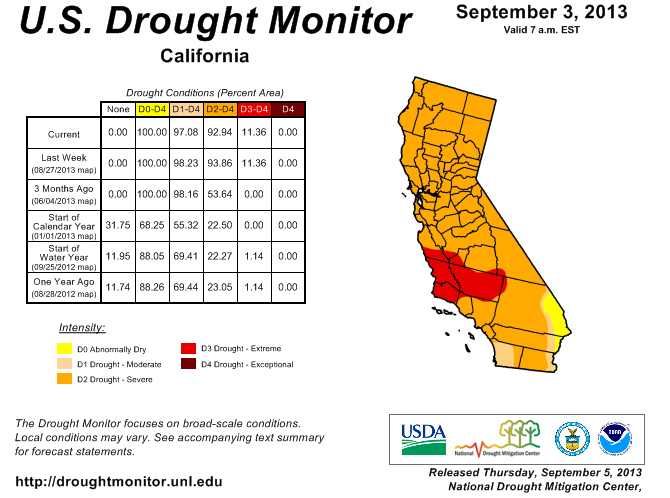From the Department of Water Resources:
The Department of Water Resources (DWR) is sponsoring events throughout the fall in preparation for the possibility that water year 2014 could be a third consecutive dry year. Preparing for the potential of continued dry conditions is also the focus of a joint California State Board of Food and Agriculture – California Water Commission meeting next week.
Water year 2012 ranked as the 25th driest year in terms of statewide runoff, based on a measured record of 112 years. Good reservoir and groundwater basin storage from a wet 2011 lessened impacts of dry conditions for many water users. Water year 2013, which ends on September 30, began with above-average precipitation but then turned dry. Sacramento Valley and San Joaquin Valley watersheds experienced record dry conditions in January through May.
Although the water year’s wet early start helped replenish storage in many reservoirs, subsequent ongoing dry conditions especially affected non-irrigated agriculture and contributed to an increased wildfire risk.
If 2014 is dry, its impacts are expected to be more widely felt due to reduced carry-over storage statewide. Advanced preparation for dry conditions helps water suppliers put in place actions to help mitigate impacts — such as enhanced water conservation programs or water transfers — and helps agricultural water users consider risk management tools such as crop insurance.
“While we hope that water year 2014 will mark a return to better water supply conditions, we must be prepared for the possibility of another dry year,” said DWR Director Mark Cowin. “Dry conditions are a recurring feature of California’s hydrologic cycle, and lessons learned from responses to previous dry periods have improved our ability to be ready in the future.”
(Click “Read The Rest of this Entry” for a list of scheduled events.)
Scheduled upcoming events:
September 10, Sacramento
Joint meeting of California State Board of Food and Agriculture – California Water Commission; Agenda and meeting information: https://cwc.ca.gov/Pages/2013/09_September/091013agenda.aspx.
September 24, San Diego
Drought preparedness training for small water systems, co-sponsored with the California Rural Water Association (CRWA) and the federal National Integrated Drought Information System (NIDIS) program.; Information: http://www.calruralwater.org/product/nidis_workshops/?oid=808
September 25, Riverside
Drought preparedness training for small water systems, co-sponsored with CRWA and NIDIS; Information: http://www.calruralwater.org/product/nidis_workshops/?oid=808
October 8, Fountain Valley
Urban drought workshop, co-sponsored with the National Water Research Institute; Agenda and registration information coming at: http://www.nwri-usa.org/events.htm#register
October 8, Palmdale
Drought preparedness training for small water systems, co-sponsored with CWRA and NIDIS; Information: http://www.calruralwater.org/product/nidis_workshops/?oid=808
October 9, Bakersfield
Drought preparedness training for small water systems, co-sponsored with CRWA and NIDIS; Information: http://www.calruralwater.org/product/nidis_workshops/?oid=808
December 17, Fresno
Agricultural drought workshop, co-sponsored with the Center for Irrigation Technology at CSU, Fresno; Agenda and registration coming at : http://www.fresnostate.edu/jcast/cit/announcements-events/
Additionally, DWR expects to release an experimental forecast for this winter’s water supply conditions in late November. This forecast is the product of a DWR-sponsored science workshop at which climate science and meteorology researchers use best available information to characterize potential seasonal conditions. The status of El Niño-Southern Oscillation (ENSO) conditions is a primary source of skill in making seasonal climate forecasts. Presently, ENSO-neutral conditions persist in the equatorial Pacific Ocean.
Background on dry conditions in water years 2012 and 2013
As of September 4, the U.S. Department of Agriculture has included all but one of California’s counties (San Francisco) in its list of 2013 drought-related agricultural disaster designations. These designations allow agricultural producers to qualify for federal financial assistance programs, such as low-interest loans.
DWR’s State Water Project allocations are 35 percent of water contractors’ requested deliveries in 2013 and were 40 percent in 2012.
The federal Central Valley Project (CVP) allocations for 2013 are: 100 percent to water rights contractors, north of Delta urban contractors, wildlife refuges, and Eastside contractors; 75 percent to north of Delta agricultural contractors, American River urban contractors, and in-Delta contractors; 70 percent to urban south of Delta contractors; 50 percent to Friant contractors; and 20 percent to south of Delta agricultural contractors
In 2012, CVP allocations were 100 percent to contractors, except for 75 percent to south of Delta urban contractors, 50 percent to Friant contractors, and 40 percent to south of Delta contractors.
California received full Colorado River deliveries in 2013 and 2012.
The Department of Water Resources operates and maintains the State Water Project, provides dam safety and flood control and inspection services, assists local water districts in water management and water conservation planning, and plans for future statewide water needs.


